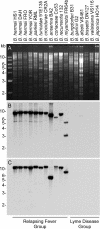Purine salvage pathways among Borrelia species
- PMID: 17502392
- PMCID: PMC1952022
- DOI: 10.1128/IAI.00199-07
Purine salvage pathways among Borrelia species
Abstract
Genome sequencing projects on two relapsing fever spirochetes, Borrelia hermsii and Borrelia turicatae, revealed differences in genes involved in purine metabolism and salvage compared to those in the Lyme disease spirochete Borrelia burgdorferi. The relapsing fever spirochetes contained six open reading frames that are absent from the B. burgdorferi genome. These genes included those for hypoxanthine-guanine phosphoribosyltransferase (hpt), adenylosuccinate synthase (purA), adenylosuccinate lyase (purB), auxiliary protein (nrdI), the ribonucleotide-diphosphate reductase alpha subunit (nrdE), and the ribonucleotide-diphosphate reductase beta subunit (nrdF). Southern blot assays with multiple Borrelia species and isolates confirmed the presence of these genes in the relapsing fever group of spirochetes but not in B. burgdorferi and related species. TaqMan real-time reverse transcription-PCR demonstrated that the chromosomal genes (hpt, purA, and purB) were transcribed in vitro and in mice. Phosphoribosyltransferase assays revealed that, in general, B. hermsii exhibited significantly higher activity than did the B. burgdorferi cell lysate, and enzymatic activity was observed with adenine, hypoxanthine, and guanine as substrates. B. burgdorferi showed low but detectable phosphoribosyltransferase activity with hypoxanthine even though the genome lacks a discernible ortholog to the hpt gene in the relapsing fever spirochetes. B. hermsii incorporated radiolabeled hypoxanthine into RNA and DNA to a much greater extent than did B. burgdorferi. This complete pathway for purine salvage in the relapsing fever spirochetes may contribute, in part, to these spirochetes achieving high cell densities in blood.
Figures






References
-
- Anand, R., A. K. Kaminski, and S. E. Ealick. 2004. Structures of purine 2′-deoxyribosyltransferase, substrate complexes, and the ribosylated enzyme intermediate at 2.0 A resolution. Biochemistry 43:2384-2393. - PubMed
-
- Becerra, A., and A. Lazcano. 1998. The role of gene duplication in the evolution of purine nucleotide salvage pathways. Orig. Life Evol. Biosph. 28:539-553. - PubMed
Publication types
MeSH terms
Substances
Associated data
- Actions
- Actions
- Actions
- Actions
- Actions
- Actions
- Actions
- Actions
- Actions
- Actions
- Actions
- Actions
- Actions
- Actions
- Actions
- Actions
- Actions
- Actions
- Actions
- Actions
- Actions
- Actions
- Actions
- Actions
- Actions
- Actions
- Actions
- Actions
- Actions
- Actions
- Actions
- Actions
- Actions
- Actions
Grants and funding
LinkOut - more resources
Full Text Sources

